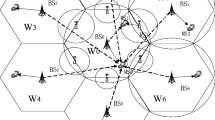Abstract
In code division multiple access network, the interference has more effect on the capacity than the other cellular networks. To increase the uplink capacity of traditional time division duplex-code division multiple access (TDD-CDMA) cellular networks, the method of two-hop relay is adopted. In this paper, we first present a two-hop relay TDD-CDMA cellular system model, and then design two kinds of time slot scheduling schemes and power control models. Based on the system model, the total interference power to target cell can be analyzed, and then the closed form expressions of the uplink capacity are obtained by mathematical calculating. Finally the impact of different system parameters on networks’ capacity is discussed.








Similar content being viewed by others
References
Gilhousen, K. S., Jacobs, I. M., Padovani, R., Viterbi, A. J., Weaver, L. A., Jr., & Wheatley, C. E., III. (1991). On the capacity of a cellular CDMA system. IEEE Transactions on Vehicular Technology, 40(2), 303–312.
Rappaport, T. S. (2002). Wireless communications, principles and practice (2nd ed., pp. 25–68). Upper Saddle River: Prentice Hall PTR.
Loa, K., Wu, C.-C., Sheu, S.-T., et al. (2010). IMT-advanced relay standards. IEEE Magazine on Communications, 48(8), 40–48.
Maryam, A., & Hong, Peter H. (2012). Performance comparison of time slot allocation schemes in TDD-CDMA multihop cellular networks. Wireless Personal Communications, 62(3), 557–576.
Hoymann, C., Wanshi, Chen, Montojo, J., et al. (2012). Relaying operation in 3GPP LTE: challenges and solutions. IEEE Magazine on Communications, 50(2), 156–162.
Pikhletsky, M., Khafizov, F., Zhang, J., et al. (2011). Dynamic radio resource management for OFDMA-based relay enhanced cellular network. In Proceedings of 2011 IEEE global communications conference. Houston, Texas, USA, pp. 1–5.
Dawy, Z. (2011). The uplink coverage-capacity trade-off in CDMA-based multihop cellular network. European Transactions on Telecommunications, 22(8), 522–533.
Radwan, A., Hassanein, H. S., & Taha, A. M. (2010). Identifying the capacity gains of multihop cellular network. IEEE Transactions on Communications, 54(2), 278–290.
Wen, J., Sheng, M., Wang, X., Li, J., & Sun, H. (2014). On the capacity of downlink multi-hop heterogeneous cellular networks. IEEE Transactions on Wireless Communications, 13(8), 4092–4103.
Chan, P. W. C., Lo, E. S., Wang, R. R., et al. (2006). The evolution path of 4G networks: FDD or TDD? IEEE Magazine on Communications, 44(12), 42–50.
Hua, Y., Zhang, Q., Niu, Z. (2010). Resource allocation in multi-cell OFDMA-based relay network. In Proceedings of 2010 IEEE international conference on computer communications. San Diego, CA, USA, pp. 1–9.
Cheung, K. T. K., Yang, S., Hanzo, L. (2013). Maximizing energy-efficiency in multi-relay OFDMA cellular networks. In Global Communications Conference (GLOBECOM), 2013 IEEE. IEEE, pp. 2767–2772.3.
Viterbi, A. J., Viterbi, A. M., & Zehavi, E. (1994). Other-cell interference in cellular powercontrolled CDMA. IEEE Transactions on Communications, 42(234), 1501–1504.
Akl, R. G., Hegde, M. V., Naraghi-Pour, M., & Min, P. S. (2001). Multicell CDMA network design. IEEE Transactions on Vehicular Technology, 50(3), 711–722.
TIA (1993). Mobile station-base station compatibility standards for dual-mode wideband spread spectrum cellular systems. In TIA/EIA interim standard (IS-95).
Acknowledegments
This work is supported by the Chinese National Research Project (2012A138); The National Basic Research Program of China (973 Program) (2011CB302903); The National Natural Science Foundation of China (61372101, 61071113, 60902012, 61201160, 61602263); The National Science and Technology Major Project of China under Grants (2012ZX03004-005-003, 2011ZX03003-003-03); Research Project of Jiangsu Province under Grants (BE2012167, BK2011019, BK20131377, BK20141427, BK20151507, BK20160916); The Six Talent Peaks Project in Jiangsu Province (XYDXXJS-044); The Natural Science Fund for Colleges and Universities in Jiangsu Province under Grants (16KJB510034); The Priority Academic Program Development Project of Jiangsu Higher Education Institutions (yx002001); Sponsored by NUPTSF (Grant Nos. NY212012, NY214065, NY213036, NY216020).
Author information
Authors and Affiliations
Corresponding author
Rights and permissions
About this article
Cite this article
Lu, W., Chen, S. & He, L. Uplink Capacity of Two-Hop Relay TDD-CDMA Cellular Networks with Time-Slot Scheduling. Wireless Pers Commun 97, 1345–1359 (2017). https://doi.org/10.1007/s11277-017-4573-9
Published:
Issue Date:
DOI: https://doi.org/10.1007/s11277-017-4573-9




